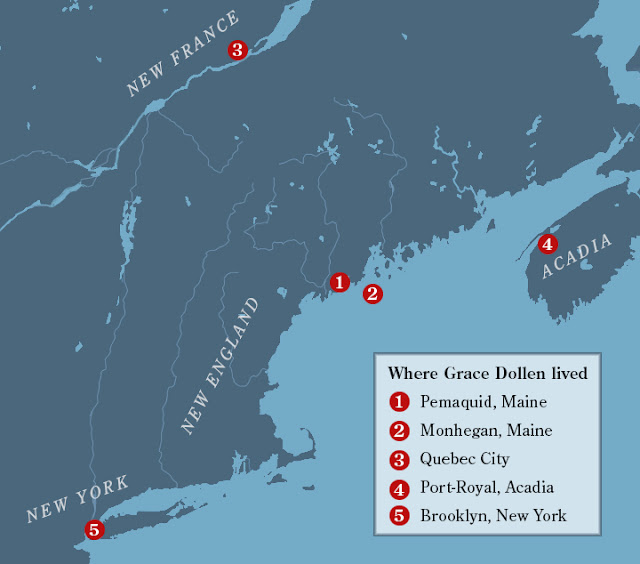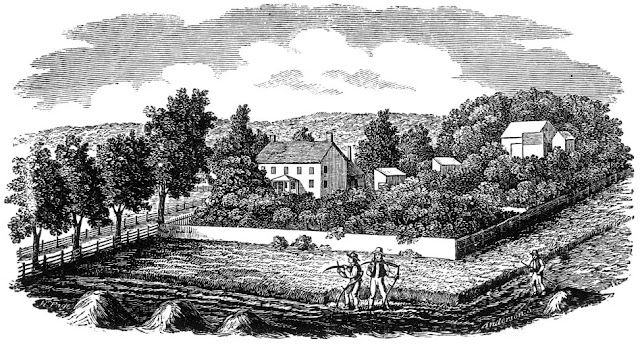M. about 1680 in Maine
Husband: Denys Hegeman
D. 19 Jan 1734 in Flatbush, New York
There are several unique things about Grace Dollen. She was someone who lived in three different American colonies in her lifetime. She bravely faced being torn away from her family and taken prisoner for several years. And her dramatic story survives in her own testimony.
Grace started out life in New England, born in the remote outpost of Pemaquid, Maine in 1659. Her father was John Dollen, and it’s believed that her mother was Sarah Gridley. During some of this time, John Dollen lived on an island called Monhegan where he operated a tavern. When Grace was growing up, these were dangerous places; the frontier was vulnerable to attacks from Indians, who were often spurred on by the French. During King Philip’s War, Pemaquid was attacked and burned — Grace must have been in the middle of all this as a teenager.
In about 1680, Grace married a Dutchman from New York, Denys Hegeman, who was in Pemaquid as a soldier. Between 1681 and 1688, they had four children. But the challenges of where they lived finally had a direct affect on Grace. On August 2, 1689, the Indians attacked Pemaquid and took around 50 settlers captive. Grace and her young daughter Jane were two of them; it’s likely that Jane was killed.
After Grace was returned from captivity many years later, she gave testimony describing her ordeal. This was sometimes done by authorities in New England to extract information about the behavior of those who threatened their colony:
“The day when Pemaquid was assaulted and taken by ye Indians, I was there taken prisoner and carried away by them; one Eken, a Canada Indian pretending to have a right in me, and to be my master. I apprehend that there were between two and three hundred Indians at that assault (and no French) who continued there for two days, and then carried myself and other captives (about fifty in number) unto the Fort at Penobscot.
“I continued there about three years, removing from place to place as the Indians occasionally went, and was very hardly treated by them both in respects of provisions and clothing, having nothing but a torn blanket to cover me during the winter seasons, and oftentimes cruelly beaten. After I had been with the Indians three years, they carried me to Quebec, and sold me for forty crowns unto the French there, who treated me well, gave me my liberty and I had the King’s allowance of provisions, as also a room provided for me, and liberty to work for myself.
“I continued there two years and a half, during which time of my abode there, several of the Eastern Indians came, viz., Bomaseen, Moxis his son, and Madockawondo’s son and diverse others, and brought English prisoners and scalps, and received as the French told me for each scalp (being paid by the intendent) twenty French crowns, according to a declaration which the governor there had emitted for their encouragement, and the captives they sold for as much as they could agree with the purchasers.
“The Indians also had a reward allowed them for bringing intelligence from time to time. Soon after the submission made by the Indians at Pemaquid in 1693, Bomaseen came to Quebec and brought a paper containing the substance of the articles of submission which he showed unto me, and told me that the governor of Canada said to him, that he should not have made peace with the English and he seemed to be much displeased for their having so done, however said they might carry it friendly to the English, till they should meet with a convenient opportunity to do mischief.”
Grace’s husband Denys made an effort to get her released in 1691 and in the process, was captured himself. In this way, they were reunited for a time in Quebec, and on March 4, 1693, Grace gave birth to a son they named Joseph. Denys was given his freedom before Grace; she left Quebec on September 4, 1694, spent the winter in Port Royal, Acadia, then made her way to Boston, arriving in May of 1695. She then was reunited with her husband and children at his home in Flatbush, New York.
“I continued there about three years, removing from place to place as the Indians occasionally went, and was very hardly treated by them both in respects of provisions and clothing, having nothing but a torn blanket to cover me during the winter seasons, and oftentimes cruelly beaten. After I had been with the Indians three years, they carried me to Quebec, and sold me for forty crowns unto the French there, who treated me well, gave me my liberty and I had the King’s allowance of provisions, as also a room provided for me, and liberty to work for myself.
“I continued there two years and a half, during which time of my abode there, several of the Eastern Indians came, viz., Bomaseen, Moxis his son, and Madockawondo’s son and diverse others, and brought English prisoners and scalps, and received as the French told me for each scalp (being paid by the intendent) twenty French crowns, according to a declaration which the governor there had emitted for their encouragement, and the captives they sold for as much as they could agree with the purchasers.
“The Indians also had a reward allowed them for bringing intelligence from time to time. Soon after the submission made by the Indians at Pemaquid in 1693, Bomaseen came to Quebec and brought a paper containing the substance of the articles of submission which he showed unto me, and told me that the governor of Canada said to him, that he should not have made peace with the English and he seemed to be much displeased for their having so done, however said they might carry it friendly to the English, till they should meet with a convenient opportunity to do mischief.”
Grace’s husband Denys made an effort to get her released in 1691 and in the process, was captured himself. In this way, they were reunited for a time in Quebec, and on March 4, 1693, Grace gave birth to a son they named Joseph. Denys was given his freedom before Grace; she left Quebec on September 4, 1694, spent the winter in Port Royal, Acadia, then made her way to Boston, arriving in May of 1695. She then was reunited with her husband and children at his home in Flatbush, New York.
Baptism of Joseph Hegeman in the New France Catholic parish registers.
Remarkably, for someone who had gone through so much, Grace was able to return to a normal life. She and Denys had another child in 1699, but it appears that Denys died in 1702 before their last child was born. Now a widow, on April 13, 1703, Grace filed a petition asking for money as a reward for the years of service of her late husband, and she was awarded £50. By this time she had become a part of the Dutch community and took on the name “Lucretia.”
Grace probably never went back to her place of birth. She died January 19, 1734 in Flatbush at the age of 75. Her lines of descent lived in New York, New Jersey, and later spread across the country — the legacy of a woman who had lived in so many places.
Children:
1. Dollens Hegeman — B. about 1681, Pemaquid, Maine; D. before 20 May 1760, (probably) Middlesex, New Jersey; M. Geertruy Bergen, 1703, Middlesex County, New Jersey
2. Adrian Hegeman — B. about 1683, Pemaquid, Maine; D. Aug 1762, Somerset County, New Jersey; M. (1) Elizabeth Van Wyck (?-1720), 15 Dec 1706, Flatbush, New York; (2) Sarah ______, before 1719
3. Catharina Hegeman — B. about 1688, Pemequid, Maine; M. (1) Hendrick Vonck (1681-bef 1735), 12 May 1706, Flatbush, New York; M. (2) Anke Lefferts Haughwot, 30 July 1735
4. Jane Hegeman — B. about 1687, Pemaquid, Maine; D. about 1699, (probably) Maine
5. Joseph Hegeman — B. 4 Mar 1693, Quebec City, New France; D. 31 Mar 1748, Flatbush, New York; M. Alida Andriesz (1699-?), 4 Jun 1714, Flatbush, New York
6. Jacobus Hegeman — B. 18 Jan 1699, Jamaica, New York; D. 25 Sep 1736, Hillsborough, New Jersey; M. Jannetje Van Vegten (1701-1778), 13 May 1721
7. Denys Hegeman — B. before 29 Jun 1703, (probably) Jamaica, New York; D. after 1762
Sources:
Ten years at Pemaquid: sketches of its history and its ruins, John Henry Cartland, 1899
"The Tribulations of Denys Hegeman," Richard W. Cook, Genealogies of New Jersey Families: A-Z, pre-American notes on New Netherland families, 1996
Register of the Early Settlers of Kings County, Long Island, N.Y., Teunis G. Bergen
Genealogy website of John Blythe Dobson, which cites many sources




















